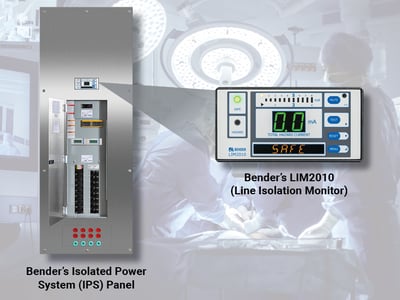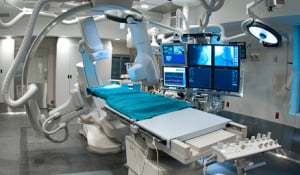Case Study: Importance of Annual Testing & Service for Isolated Power Panels Within Healthcare Facilities

Over the last century, Bender's isolated power systems (IPS) have become the go-to method of electrical protection in medical facilities. These areas within the facility are often more vulnerable to shock and therefore, require extra protection, not only for added safety to patients and staff, but also to remain compliant with national and local safety codes. At the heart of these systems is a line isolation monitor (LIM), a predictive device that monitors the IPS and alerts staff audibly and visually in a first-ground fault condition. This allows clinical staff to quickly correct the issue in case a quick solution is possible and continue the procedure without interruption, all while maintaining a high degree of safety. With such a critical role played in the function of the isolated power system, LIMs must be regularly maintained and tested so that defects and failures are caught early.
Bender's Service Offerings
Bender's wide range of service offerings include:
- Annual testing of all isolated power systems by a Bender-authorized technician that includes:
- Ensuring the continued functionality of the system’s LIM and any remote indicators that are also connected
- Confirmation that the audible and visual alarms on the units are fully functioning
- Simulation of a first-fault condition on the system to measure the functionality and accuracy of the LIM’s measuring software
- Training of staff to understand what this all means and know what to do when the system alarms
- The technician will also fully assess the system, noting apparent deficiencies such as:
- Failure to read or alarm
- Indication of a unit approaching failure
- Units reading progressively more inaccurately or wandering in their readings
In facilities where ongoing annual maintenance has not been prioritized, a preventative maintenance inspection can also identify equipment that, while still functioning, no longer complies with current code requirements.
Much of the safety in an IPS comes from the ability to acknowledge and correct a first fault condition, without losing power, before a second fault occurs. However, on a system with excessive nuisance alarms, clinical staff can get used to the LIM alarming for minimal leakage current, tune it out, and not take action to correct or investigate the root cause. The danger, then, is that if a fault condition does occur when the total hazard current well exceeds the 5 mA maximum, the staff won’t notice it as anything out of the ordinary, leaving them vulnerable to the second fault.
Automatic Fault Location Solution
In a well-maintained system, the LIM only alarms when there is a ground fault, allowing the clinical staff to acknowledge the fault, complete their procedure, and report it to their engineering staff to rectify that first fault condition. A properly functioning, non-nuisance alarming LIM and the added security of a fault location system, like the Bender EDS441 fault location system, ensures that ground faults are quickly and efficiently addressed by identifying the specific circuit with the ground fault. This technology promotes minimal downtime for the operating room and maximum safety for patients and staff.
🎥 WATCH: Fault Location Technology in Action
Real-life Example
Recently, Bender’s service team was dispatched to a California hospital to perform annual testing on 13 isolated power systems. The line isolation monitors in these systems were a mix of antiquated analog monitors and more recent, but still obsolete, digital monitors dating from the early 2000s. While most of the older digital monitors passed functionality and code testing, the analog monitors failed. These analog monitors had an alarm threshold of 2 mA for a first-fault condition, which is well below the current code standard of 5 mA.
When speaking with the clinical staff, it was discovered that many of these rooms experienced nuisance alarming due to this low threshold. In addition to the lower, non-code-compliant threshold, several monitors failed functionality testing. Several lighting indicators did not illuminate, and in a few concerning instances, when a simulated fault was applied to the system (higher than 5 mA), the monitor read nearly 2 mA beyond the appropriate THC (total hazard current). This large of a discrepancy between the monitor’s internal calculations and the known condition of the system indicates that the monitor’s internal software is no longer functioning at a dependable level and it should be replaced immediately.
In total, 7 of the 13 systems tested at this facility were out of compliance with code and functionality. Upon receiving this data from the field technician, the Bender team constructed a remediation plan to correct the deficiencies with as few interruptions to the hospital as possible. Retrofit kits specific to the style of panel present at the facility were selected, along with the appropriate remote indication, to ensure that the new monitors would fit and function with the existing equipment. After they are installed, the Bender team will return to re-certify the panels annually, confirming that the new LIMs are fully functioning and correctly monitoring the isolated power system, returning those operating rooms to the level of safety assuredness that clinicians have come to expect.
Contact Our Team for Service Assistance
With all life safety equipment, it is critical to ensure proper use and function through proper preventative maintenance measures. The due diligence of Bender-authorized technicians and the Bender service team allows healthcare facilities, their clinical staff, patients, and families, to enjoy the full coverage of electrical safety during procedures by ensuring the peak performance of the isolated power systems.
Our service team is ready to assist you. If your facility is in need of annual testing, or you simply want more information, contact our team of experts.
This article is for informational purposes only. Bender provides the information "as is" without warranty and is not responsible for its accuracy or reliability. No warranties are given regarding its suitability for any specific circumstances.



.jpg?width=352&name=Blank%20300%20x%20175%20(23).jpg)
